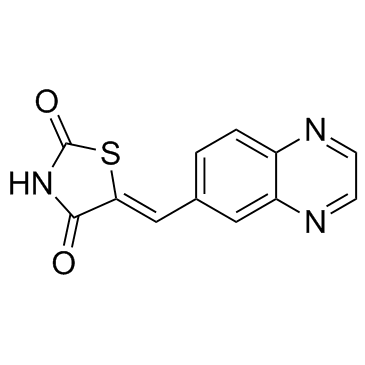648450-29-7
| Name | 5-(6-Quinoxalinylmethylene)-2,4-thiazolidine-2,4-dione |
|---|---|
| Synonyms |
PI 3-Kinase Inhibitor
AS605240 2,4-Thiazolidinedione, 5-(6-quinoxalinylmethylene)-, (5Z)- (5Z)-5-(Quinoxalin-6-ylmethylene)-1,3-thiazolidine-2,4-dione (5Z)-5-(6-Quinoxalinylmethylene)-1,3-thiazolidine-2,4-dione 5-quinoxalin-6-ylmethylenethiazolidine-2,4-dione AS 605240 AS-605240 |
| Description | AS-605240 is a specific and orally active inhibitor of the PI3Kγ, with an IC50 of 8 nM, and a Ki of 7.8 nM. |
|---|---|
| Related Catalog | |
| Target |
PI3Kγ:8 nM (IC50) PI3Kα:60 nM (IC50) PI3Kβ:270 nM (IC50) PI3Kδ:300 nM (IC50) Autophagy |
| In Vitro | AS-605240 is an isoform-selective inhibitor of PI3Kγ with over 30-fold selectivity for PI3Kδ and β, and 18- and 7.5-fold selectivity over PI3Kα, respectively. AS-605240 shows an inhibitory effect on C5a-mediated PKB phosphorylation in RAW264 mouse macrophages with an IC50 of 0.09 μM. AS-605240 blocks PKB phosphorylation induced by MCP-1 and has little or no effect after stimulation with CSF-1. AS-605240 inhibits MCP-1-mediated phosphorylation of PKB and its downstream substrates GSK3α and β in a concentration-dependent manner. AS605240 suppresses in a dose-dependent manner the proliferation of BDC2.5 CD4+ T cells[2]. |
| In Vivo | AS-605240 (30 mg/kg BW, per os, every 12 h) markedly decreases FoxM1 expression in mouse lungs and fails to restore vascular integrity[1]. AS-605240 reduces RANTES-induced peritoneal neutrophil recruitment, with ED50 of 9.1 mg/kg. In the CCL5 model, AS-605240 shows an ED50 value of 10 mg/kg, in correlation with the percentage of reduction of neutrophil recruitment observed in Pik3cg-/- mice. AS-605240 (50 mg/kg, p.o.) substantially reduces clinical and histological signs of joint inflammation to a similar extent to that of Pik3cg-/- mice[2]. AS605240 (30 mg/kg, i.p.) suppresses intracellular PAkt in splenocytes of NOD mice and delays diabetes onset. AS605240 also prevents autoimmune diabetes in prediabetic NOD mice, and suppresses autoreactive T cells while increasing Tregs in NOD mice. AS605240 (30 mg/kg, i.p.) reverses hyperglycemia in newly hyperglycemic NOD mice, reverses hyperglycemia in early diabetic NOD mice through Tregs and suppresses T-cell infiltration in pancreatic islets while increasing Tregs[3]. AS605240 (25, 50 mg/kg) markedly reduces total cell count and numbers of macrophages, neutrophils and lymphocytes in rats. AS605240 significantly reduces the levels of TNF-α and IL-1β in BALF to 132.7±11.2 pg/mL and 49.2±11.3 pg/mL in 25 mg/kg AS605240 + BLM group and 131.3±10.7 and 49.6±8.8 pg/mL in 50 mg/kg AS605240 + BLM group, respectively. AS605240 inhibits prefibrotic cytokines production in bleomycin-induced pulmonary fibrosis. AS605240 inhibits phosphorylation of Akt of inflammatory cells in bleomycin-induced pulmonary fibrosis model[4]. |
| Kinase Assay | Human PI3Kγ (100 ng) is incubated at RT with kinase buffer (10 mM MgCl2, 1 mM β-glycerophosphate, 1 mM DTT, 0.1 mM Na3VO4, 0.1% Na Cholate and 15 M ATP/100 nCi γ[33P]ATP, final concentrations) and lipid vesicles containing 18 M PtdIns and 250 M of PtdSer (final concentrations), in the presence of inhibitors or DMSO. Kinase reaction is stopped by adding 250 g of Neomycin-coated Scintillation Proximity Assay (SPA) bead and proceeded. |
| Cell Assay | A total of 5×105 BDC2.5 splenocytes and 50 μg/mL BDC2.5-peptide are incubated in vitro in a 96-well round-bottom plate for 48 h. Then the cultures are pulsed with 1 μCi of tritiated thymidine [3H] to determine cell proliferation. |
| Animal Admin | In this study, rats are bred for one week to affirm body weight and then randomLy divided into four experimental groups: (a) control group (rats are given vehicle only); (b) BLM group (rats are induced with BLM); (c) BLM + 25 mg/kg AS605240 group (rats are induced with BLM and then administrated with 25 mg/kg AS605240); (d) BLM + 50 mg/kg AS605240 group (the same protocol as the former group except a different dose of 50 mg/kg AS605240). In addition, five rats are given 50 mg/kg AS605240 only to detect whether AS605240 has any side effect simultaneously as the previous four groups. Rats in (c), (d) and AS605240-given-only group are administered orally 25, 50 and 50 mg/kg AS605240 by gavage while rats in control group and BLM group are given only equivalent saline at day-1 (the day rats are given BLM is marked as day-0). The same dosage is maintained once everyday for 28 days. |
| References |
| Density | 1.6±0.1 g/cm3 |
|---|---|
| Molecular Formula | C12H7N3O2S |
| Molecular Weight | 257.268 |
| Exact Mass | 257.025909 |
| PSA | 97.25000 |
| LogP | 0.52 |
| Appearance | , faint red to orange to dark brown |
| Index of Refraction | 1.792 |
| Storage condition | 2-8°C |
| Water Solubility | DMSO: soluble1mg/mL, clear (warmed) |
| Symbol |

GHS07 |
|---|---|
| Signal Word | Warning |
| Hazard Statements | H315-H319-H335 |
| Precautionary Statements | P261-P305 + P351 + P338 |
| Personal Protective Equipment | dust mask type N95 (US);Eyeshields;Gloves |
| Hazard Codes | Xi |
| Risk Phrases | 36/37/38 |
| Safety Phrases | 26 |
| RIDADR | NONH for all modes of transport |
